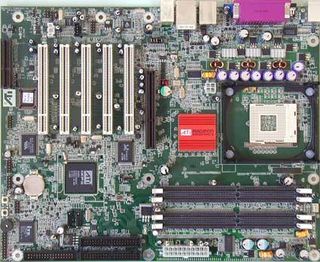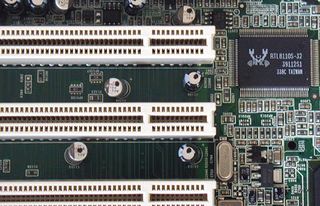ATI's Radeon 9100 Pro IGP Takes Aim at Intel's Chipset Launch
ATI Reference Motherboard

BIOS Version: TST422_01
The ATI reference motherboard, built by one of the biggest motherboard makers in Taiwan, gives the impression of a standard retail motherboard. It comes equipped with a Gigabit Ethernet controller from Realtek, a Firewire chip, a sound system, a CNR slot (communications & network riser) and two Serial ATA ports that add to the dual-channel UltraATA/100 controller.
However, turning it around reveals the real nature of this motherboard. Several bumpers are housed at the bottom of the board. They enable reviewers to operate it on a flat surface rather than installing it anywhere. In addition, this board features on/off and reset switches in hardware that proved to be valuable.
After flashing the latest BIOS version (ATI calls it Gator BIOS) we ran into heavy troubles, as our efforts to boot WindowsXP ended in a strange dead lock: Persuading the board to boot from our Serial ATA drive had to be done in the BIOS setup. Unfortunately the system crashed whenever we tried to "save & exit." We were able to track our Pentium 4 Prescott validation sample as the culprit for this mess. Obviously, the reference board cannot cope with unlocked processor multipliers.
Exchanging the processor with a retail CPU solved the problem instantly and ATI's prototype became gentle again. Special thanks to ATI at this point, as they managed to provide a processor faster than we would have been able to locate.
As the benchmark result differences between the Radeon 9100 IGP and the pro-version reference board are negligible, we did not include benchmark numbers for it. Once again, ATI manages to outperform Intel's 865G chipset in graphics benchmarks by up to 120% when using the integrated graphics engines, but cannot keep pace with other, non-graphics benchmarks. That does not apply when using an AGP graphics card: Equipped with ATI's Radeon 9800XT, the Intel platform deals out blows to ATI's 9100 Pro IGP.



Stay on the Cutting Edge
Join the experts who read Tom's Hardware for the inside track on enthusiast PC tech news — and have for over 25 years. We'll send breaking news and in-depth reviews of CPUs, GPUs, AI, maker hardware and more straight to your inbox.
Current page: ATI Reference Motherboard
Prev Page The Competitors: Intel 865G And 915G Next Page Test SetupMost Popular

